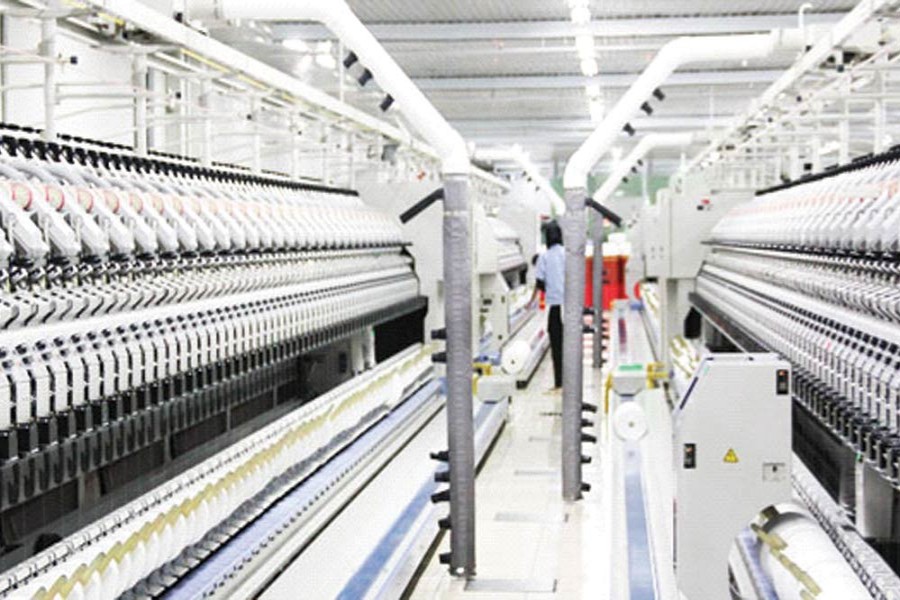
Published :
Updated :

Spinning industry in Bangladesh has reached a mature stage and it is now looking for consolidation. Spinning mills are challenged with eroding profit margin, increasing cost of power and rise in wages, which were among the strengths only a decade ago when SWOT (Strengths, Weaknesses, Opportunities and Threats) analysis was done. But if we look at the total cost, power and labour costs had 07 per cent and 03 per cent share respectively a decade ago. But of late, the costs have reached 10 per cent and 06 per cent respectively. Still, we are left with 84 per cent to work on for increasing the spinning sector profitability.
The question that may come before us is how? Raw material, which roughly covers 60 per cent of the cost of goods sold, is still undermanaged and unfocused. Then there comes the productivity of our spinning mills, which are running at least 10 per cent low on productivity when compared with the competing countries like India, Pakistan, China, Indonesia or Korea. Hence, raw material and productivity alone can show us the light to help improve the margin in spinning business. Of course, efficiency is required in a matured market in all areas with an overall strategic management plan.
It is feared that interest rate would soon reach two digits and local currency would be devalued. However, these challenges are for the future. Capital market is not a source of funding as of now but we think it should be an important part of financing plan. We also need to be prepared for the consequences of the graduation from the least developed country (LDC) status in the near future.
It is estimated that the overall size of the spinning industry will increase by 50 per cent. Some suggestions toward ensuring sustainable growth of the industry include:
- Replacement of inefficient machinery and equipment: This is a major area in the industry covering 40 per cent of investment. Technology development in power generation over the last 20 years has allowed a generator of 1 mega to get replaced with a 1.5 mega generator and it would consume the same quantity of fuel (gas). A card of 1997 that could produce 42 kg per hour can now produce 90 kg almost with the same power and space. Focus should be on replacement of major spinning components like motors, spindles, rings, and systems (humidification, waste minimisation and recycling, SCM, ERP, MIS, PMS, QMS, HRM, SOP, etc) to make the spinning industry energy-efficient, productive and profitable. These replacement decisions are being made gradually and expected to get momentum in future.
- New investment and expansion in 100 per cent cotton yarn spinning: A second major investment, to the extent of roughly 30 per cent, may be made in this area. As the garment export and domestic market is growing, investment in spinning sector is also increasing. A predominately cotton knit garment exporter, Bangladesh requires cotton ring carded and combed yarn. Therefore, ring investment should be made in mostly carded with auto-doffing and compact attachment. Now average count is Ne 30/s and at least 10 per cent would target Ne 40/s+ and 15 per cent in combed compact knitting and weaving yarn. Due to rise in denim investment ring as well as rotor spinning, it would come in course of counts that would constitute the remaining 05 per cent.
- New investment and expansion in blended yarn spinning: About 15 per cent investment may come in this particular area. Blended yarn investment would be dominated by air jet spinning or Vortex. Not only Vortex market is expanding, Vortex yarn is in advantageous position over ring yarn whenever comes the question of ensuring quality, particularly for pilling. Moreover, costing of Vortex yarn is advantageous compared to ring yarn.
- Specialty yarn: Remaining 15 per cent investment may come in this section. It would be dominated by yarn that has demand in market, but is less available locally like recycled yarn, new and specialty blended yarn, special count yarn, and mélange yarn.
The focus should be on producing efficiently and running with marginal profit and manage unsystematic risks across the spinning process including planning, material, process, system, marketing, finance, currency, interest, capital market and people. Workers and management team should work hand in hand to successfully manage spinning business profitably enjoying support and direction from the entrepreneurs and the government would provide necessary infrastructure and policy guidelines ideal for sustainable growth.
The writer is Management Consultant, TRANSFORM.


 For all latest news, follow The Financial Express Google News channel.
For all latest news, follow The Financial Express Google News channel.